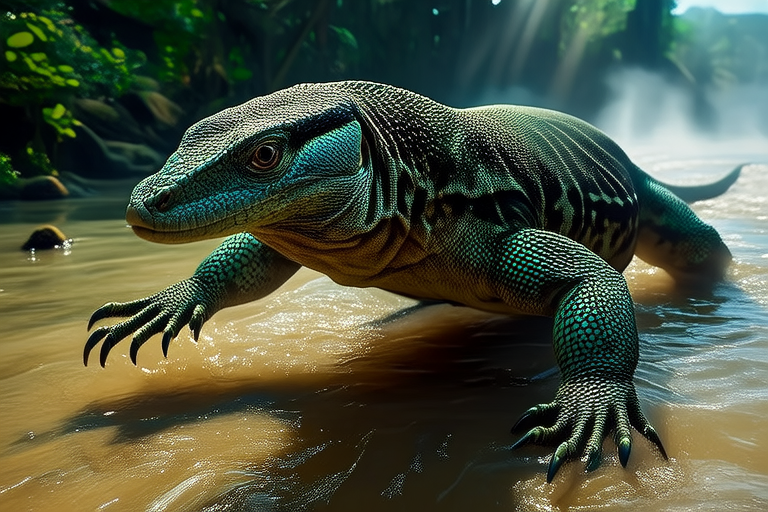Aquatic Agility: Discovering the Thrills of Owning a Water Monitor
Imagine a pet that combines the grace of a swimmer with the stealth of a hunter. The water monitor (Varanus salvator) is one such creature, a reptile that captivates its owners with its agility and adaptability. These lizards, native to Southeast Asia, are known for their ability to thrive both on land and in water. This article delves into the world of water monitors, exploring their unique characteristics, the responsibilities of ownership, and the rewarding relationship that can develop between these animals and their human companions.
The Unique Characteristics of Water Monitors
Water monitors are among the largest lizards in the world, with some individuals reaching lengths of over six feet. Their streamlined bodies and powerful tails make them excellent swimmers, capable of diving to depths of up to 45 meters. On land, they move with surprising speed, utilizing their strong legs and sharp claws to navigate through dense vegetation. Their keen eyesight and sense of smell allow them to locate prey efficiently, whether it be in the water or on the ground.
One of the most fascinating aspects of water monitors is their intelligence. They are known to exhibit problem-solving behavior and have been observed using tools, such as sticks, to reach food. This intelligence, combined with their natural curiosity, makes them endlessly engaging companions for those who take the time to understand them.
Responsibilities and Considerations for Potential Owners
Owning a water monitor is a significant commitment that requires careful planning and preparation. Before bringing one home, it’s essential to consider several factors, including habitat setup, dietary needs, and healthcare.
Habitat Setup
A water monitor’s enclosure should mimic its natural environment as closely as possible. This means providing ample space for swimming and basking. A large, secure tank or outdoor enclosure is necessary to accommodate the lizard’s size and activity level. The enclosure should include a deep water area, a basking spot, and plenty of hiding places. Water quality must be maintained at all times, with regular filtration and water changes to prevent disease.
Dietary Needs
Water monitors are carnivorous and require a varied diet to stay healthy. In captivity, their diet typically consists of commercially available frozen-thawed rodents, insects, and fish. It’s important to ensure that the food items are appropriately sized for the lizard’s age and size to prevent choking or digestive issues. Some owners also supplement their monitors’ diets with vitamins and minerals to ensure optimal health.
Healthcare
Regular veterinary check-ups are crucial for maintaining the health of your water monitor. Common health issues include respiratory infections, parasites, and metabolic bone disease, which can be prevented with proper husbandry and nutrition. Owners should also be vigilant about signs of stress or discomfort, such as lethargy, loss of appetite, or abnormal behavior.
The Bond Between Owner and Pet
While water monitors may seem intimidating due to their size and wild nature, many owners report developing a strong bond with their pets. Regular interaction, handling, and positive reinforcement can help build trust and reduce aggression. These lizards are intelligent and can learn to recognize their owners, responding to cues and commands. However, it’s important to remember that they are still wild animals and should be treated with respect and caution at all times.
Challenges for New Owners
Owning a water monitor is not without its challenges. One of the primary difficulties is providing an appropriate habitat that meets the lizard’s needs. Due to their size and activity level, water monitors require a large enclosure, which can be expensive and difficult to set up. Additionally, their dietary requirements can be complex, requiring a varied and nutritionally balanced diet.
Another challenge is the potential for aggression. While water monitors can become tame with consistent handling, they are still capable of delivering powerful bites and scratches if they feel threatened. It’s important for owners to handle their lizards with care and respect, understanding their limits and boundaries.
Where to Find Reliable Information and Support
If you’re considering owning a water monitor, it’s crucial to seek out reliable sources of information and support. Reputable herpetological societies, local reptile clubs, and experienced breeders can provide valuable guidance on饲养水巨蜥的方方面面。从设置合适的栖息地到满足它们的饮食需求,再到确保它们的健康,每一个环节都需要精心规划和准备。水巨蜥需要一个能够模仿其自然环境的大型、安全的笼子或户外围栏。这不仅包括游泳和晒太阳的空间,还需要深度的水区、晒台和许多藏身之处。水质必须始终保持良好,定期进行过滤和换水以防止疾病。
饮食需求
水巨蜥是肉食性的,需要多样化的饮食来保持健康。在圈养环境中,它们的饮食通常包括冷冻解冻后的啮齿动物、昆虫和鱼。为了防止哽咽或消化问题,重要的是确保食物项 目的大小适合蜥蜴的年龄和大小。一些主人还会通过补充维生素和矿物质来确保最佳健康。
医疗保健
定期兽医检查对于保持您的水巨蜥的健康至关重要。常见健康问题包括呼吸系统感染、寄生虫和代谢性骨病,这些都可以通过适当的管理和营养来预防。主人还应时刻注意压力或不适的迹象,如无精打采、食欲不振或异常行为。
主人与宠物之间的纽带
尽管水巨蜥可能由于其体型和野性而显得令人畏惧,但许多主人报告说他们与宠物之间建立了牢固的纽带。通过定期互动、处理和积极强化,可以建立信任并减少攻击性。这些蜥蜴是聪明的,并且可以学会识别他们的主人,对提示和命令做出反应。然而,重要的是要记住,它们仍然是野生动物,应该始终以尊重和谨慎对待。
新主人面临的挑战
饲养水巨蜥并非没有挑战。主要困难之一是提供一个能符合蜥蜴需求的适当栖息地。由于它们的体型和活动水平,水巨蜥需要一个大型笼子,这可能会很昂贵且难以设置。此外,它们的饮食要求可能很复杂,需要多样化且营养均衡的饮食。
另一个挑战是潜在的攻击性。虽然水巨蜥在一致处理的情况下可以变得温顺,但如果它们感到受到威胁,它们仍然有能力咬伤和抓伤。重要的是,主人要小心谨慎地处理他们的蜥蜴,理解它们的极限和界限。
寻找可靠的信息和支持
如果您正在考虑饲养水巨蜥,找到可靠的信息来源和支持至关重要。信誉良好的爬行动物协会、当地的爬行动物俱乐部和有经验的繁殖者可以提供关于饲养水巨蜥的宝贵指导。
